| Midway Deluxe Edition:
Japanese Carrier Pieces, Part One
By Mike Bennighof, Ph.D.
November 2024
 The Battle of Midway saw the clash of carrier fleets, with no surface ships exchanging any fire or even sighting one another. That makes each side’s aircraft carriers the most important pieces on the board. The Battle of Midway saw the clash of carrier fleets, with no surface ships exchanging any fire or even sighting one another. That makes each side’s aircraft carriers the most important pieces on the board.
In Second World War at Sea: Midway Deluxe Edition, all of the pieces have beautiful new artwork. Let’s have a brief look at the Japanese heavy carriers, and their brand-new drawings.
The Battle Cruiser
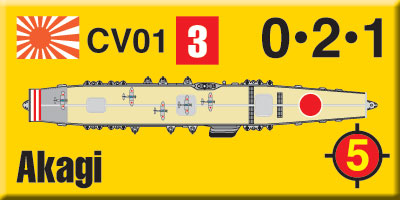
Japan’s first full-sized aircraft carrier, Akagi had been laid down in 1920 as a battle cruiser and taken in hand for conversion in 1923. Launched in 1925, she commissioned in 1927 with three flight decks - one main deck, and two shorter ones forward to allow aircraft to launch while the main deck was involved in recovering others.
That didn’t work out very well, and in 1936 she went to Sasebo Naval Dockyard for reconstruction along the same lines as Kaga (see below). She kept most of her power plant, but received new boilers. The new flight deck covered the entire length of the hull, and now included a small island as well. She operated 63 aircraft, though she had been rated for 91 when re-commissioned. With her large flight deck and hangars, good speed and crack crew, she remained a very capable ship when she steamed for Midway.
The Battleship
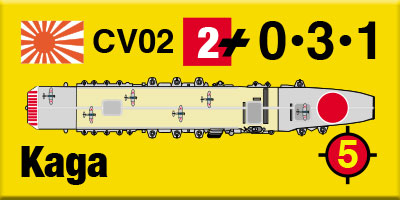
Japan’s largest carrier (by a slight margin), Kaga had been laid down in 1920 as a battleship, and converted to an aircraft carrier after the original choice, Akagi’s sister Amagi, was heavily damaged in the Great Kanto Earthquake of 1922. The Japanese could have substituted one of Akagi’s two remaining sisters, but those had been laid down a year later so the Imperial Navy chose the more advanced battleship hull to speed completion.
Kaga finally emerged from the Yokosuka Naval Dockyard in 1928 as a flush-decked carrier, with three separate flight decks, none of them extending the full length of the ship. Ideally, this would allow the carrier to recover and launch aircraft on a very rapid cycle, but in practice the middle flying-off deck, only 15 meters long, was completely useless and the lower flying-off deck at 55 meters quickly lost effectiveness as aircraft grew in size and weight.
Kaga went to Sasebo Naval Dockyard in 1934 for another total reconstruction. Her hull was lengthened by 10 meters to improve her speed, and she received new boilers and turbines. The flight deck was extended to the bow, with the two lower flight decks replaced with extended hangar decks. As rebuilt she could make 28 knots and theoretically carry 90 aircraft, though in practice she operated a smaller air group. Though slower than the other carriers, her huge and very high flight deck made her a very good platform for air operations, and she was noted in the Combined Fleet as a happy ship to serve aboard.
The First Real Carrier
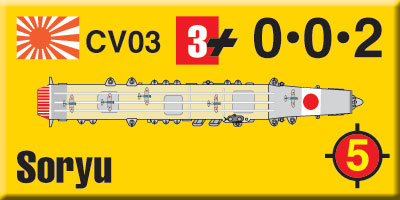
After some study of cruiser-carrier designs with 8-inch guns mounted in turrets, the Imperial Navy settled on a lightly-built and very fast ship as its first carrier built as such from the keel up. Soryu displaced 18,000 tons, less than half of Akagi or Kaga, but with two full-length hangar decks and three elevators she could operate nearly as many aircraft as the two bigger and older flattops.
Daily Content includes no AI-generated content or third-party ads. We work hard to keep it that way, and that’s a lot of work. You can help us keep things that way with your gift through this link right here.
Soryu commissioned in the last days of 1937; she provided air support to Japanese operations in China and later in Indo-China. Designed to carry 68 aircraft, in practice she operated up to 57 planes. Her armament, unlike the earlier carriers, consisted purely of anti-aircraft weapons: a dozen 5-inch guns and 28 light weapons. Also unlike the earlier carriers she carried no meaningful armor protection; her fighters would have to provide her defense.
The Improved Model
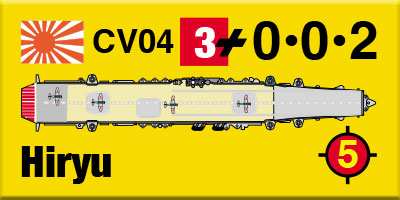
While Hiryu is sometimes described as a sister ship to Soryu, this isn’t really accurate. For starters, Soryu had her island on the starboard side of the flight deck while Hiryu’s was sited to port. Hiryu, laid down two years after Soryu, incorporated numerous improvements and weighed in 2,000 tons heavier as a result. She had considerably greater range than Soryu, and much more armor protection - though still no more than a light cruiser.
Like Soryu, Hiryu shared the same power plant as the Mogami-class light cruisers (later rebuilt as heavy cruisers). Hiryu had not been laid down when the torpedo boat Tomozuru capsized in an early 1934 storm. The realization that most Japanese warships were dangerously top-heavy led to widespread modifications to existing ships, and design changes to ships like Hiryu. She became wider as a result, allowing greater fuel stowage and that increased belt armor. She operated just two more planes than Soryu, but was considered a very successful design and was copied for the Unryu class of wartime carriers.
Missing the Party
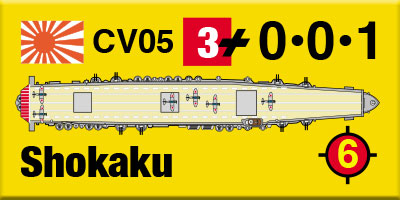
The First Air Fleet attacked Pearl Harbor with six heavy carriers, but two of them had been detached for the operations in the Solomons area that led to the Battle of the Coral Sea in May. Neither participated in the Midway operation due to battle damage to one and air group losses to the other.
The Shokaku class of two ships were vastly enlarged versions of Hiryu, with an increase of more than 10,000 tons’ displacement and a hull 100 feet longer. Shokaku was laid down in 1937 and Zuikaku a year later; they completed in August and September 1941 respectively. They operated only slightly more aircraft than the previous class, with a capacity of 72 operations planes plus a dozen more disassembled aircraft in reserve. In practice they rarely carried that may aircraft thanks to shortages of modern planes and the pilots to fly them, even in the war’s earliest months.
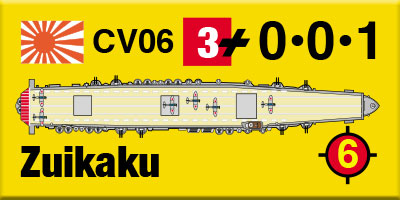
The two carriers had the same heavy anti-aircraft armament as Hiryu; they had less than half as many light guns but since the Japanese 25mm automatic cannon was nearly useless anyway, this wasn’t as great a loss as it might appear. Balancing that, they had much better armor protection than Hiryu.
Neither ship participated at Midway, though a number of aircrew were transferred to the other four carriers of First Air Fleet to make good losses there. Zuikaku departed Japan on 15 June 1942 to join in the Aleutians operation, and would be recalled soon after. She easily could have joined the First Air Fleet at Midway; she had a cobbled-together air group like those of the two light carriers sent to the Aleutians and apparently the Japanese admirals did not want a less-efficient carrier operating alongside the well-integrated squadrons of the other four carriers. Shokaku left drydock on 27 June and re-joined the fleet on 14 July; she could only have participated at Midway had the operation been delayed and that was never a consideration.
And those are the Japanese heavy carriers. Next time, we’ll look at the Japanese light carriers.
You can order Midway Deluxe right here.
Sign up for our newsletter right here. Your info will never be sold or transferred; we'll just use it to update you on new games and new offers.
Mike Bennighof is president of Avalanche Press and holds a doctorate in history from Emory University. A Fulbright Scholar and NASA Journalist in Space finalist, he has published a great many books, games and articles on historical subjects; people are saying that some of them are actually good.
He lives in Birmingham, Alabama with his wife, three children, and new puppy. He misses his lizard-hunting Iron Dog, Leopold.
Daily Content includes no AI-generated content or third-party ads. We work hard to keep it that way, and that’s a lot of work. You can help us keep things that way with your gift through this link right here.
|
